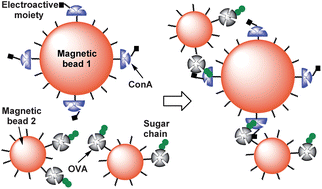Electrochemical assay of concanavalin A–ovalbumin binding on magnetic beads
Abstract
To monitor

* Corresponding authors
a
Maebashi Institute of Technology, Gunma 371-0816, Japan
E-mail:
kzsuga@maebashi-it.ac.jp
b Faculty of Education, Gunma University, Gunma 371-8510, Japan
c Department of Environmental Biology and Chemistry, Graduate School of Science and Engineering for Research, University of Toyama, Gofuku 3190, Toyama, Japan
d Basic Sciences for Medicine, Gunma University School of Health Sciences, Gunma 371-8511, Japan
To monitor

 Please wait while we load your content...
Something went wrong. Try again?
Please wait while we load your content...
Something went wrong. Try again?
K. Sugawara, A. Yugami, T. Kadoya, H. Kuramitz and K. Hosaka, Analyst, 2012, 137, 3781 DOI: 10.1039/C2AN35667H
To request permission to reproduce material from this article, please go to the Copyright Clearance Center request page.
If you are an author contributing to an RSC publication, you do not need to request permission provided correct acknowledgement is given.
If you are the author of this article, you do not need to request permission to reproduce figures and diagrams provided correct acknowledgement is given. If you want to reproduce the whole article in a third-party publication (excluding your thesis/dissertation for which permission is not required) please go to the Copyright Clearance Center request page.
Read more about how to correctly acknowledge RSC content.
 Fetching data from CrossRef.
Fetching data from CrossRef.
This may take some time to load.
Loading related content
